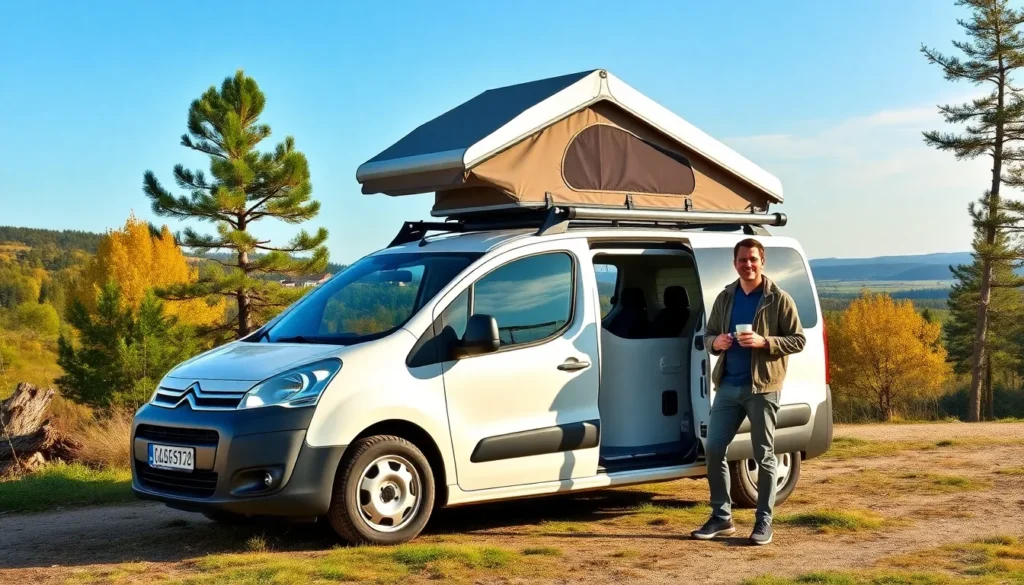The Citroën Berlingo camper has quietly revolutionized the industry of compact van conversions, offering adventure seekers an affordable gateway to the nomadic lifestyle. We’ve watched this unassuming French utility van transform from a simple commercial vehicle into one of Europe’s most beloved micro-campers, and it’s easy to see why.
What makes the Berlingo camper so compelling isn’t just its budget-friendly price point – it’s the perfect blend of practicality and adventure-ready features that larger motorhomes simply can’t match. We’re talking about a vehicle that’ll slip into tight parking spaces, navigate narrow European streets with ease, and still provide everything you need for comfortable road trips.
Whether you’re planning weekend getaways or extended European adventures, the Berlingo camper delivers surprising versatility in a compact package. We’ll explore why this little French van has captured the hearts of camper enthusiasts worldwide and how it might just be the perfect entry point into van life.
What Is the Citroën Berlingo Camper?
The Citroën Berlingo camper transforms a compact French utility van into a fully functional mobile living space designed for weekend getaways and extended road trips. Manufacturers like Westfalia, Tinkervan, and independent converters modify the standard Berlingo chassis to include sleeping arrangements, cooking facilities, and storage answers within its modest dimensions.
Our research shows the Berlingo measures 4.4 meters in length and 1.8 meters in width, making it significantly smaller than traditional motorhomes while maintaining essential camping amenities. Professional conversions typically feature a rear bench seat that converts into a double bed measuring 1.9 meters by 1.3 meters, accommodating two adults comfortably.
Standard camper configurations include a compact kitchenette with a single-burner gas stove, 12-volt refrigeration unit, and fresh water tank holding 20-40 liters depending on the conversion package. Storage compartments use every available space, with overhead cabinets, under-bed drawers, and rear door organizers maximizing the limited interior volume.
The Berlingo’s sliding side doors and rear barn doors provide multiple access points and natural ventilation, while roof windows or pop-top options in premium conversions add headroom and natural light. Electrical systems feature 12-volt LED lighting, USB charging ports, and leisure batteries ranging from 75-100 amp hours to power essential devices during off-grid camping.
Base models start around €25,000 for basic conversions, while fully equipped versions with diesel heating, solar panels, and premium materials reach €45,000. Factory camper variants from Citroën include the SpaceTourer Rip Curl edition, which combines OEM reliability with purpose-built camping features.
Key Features and Specifications
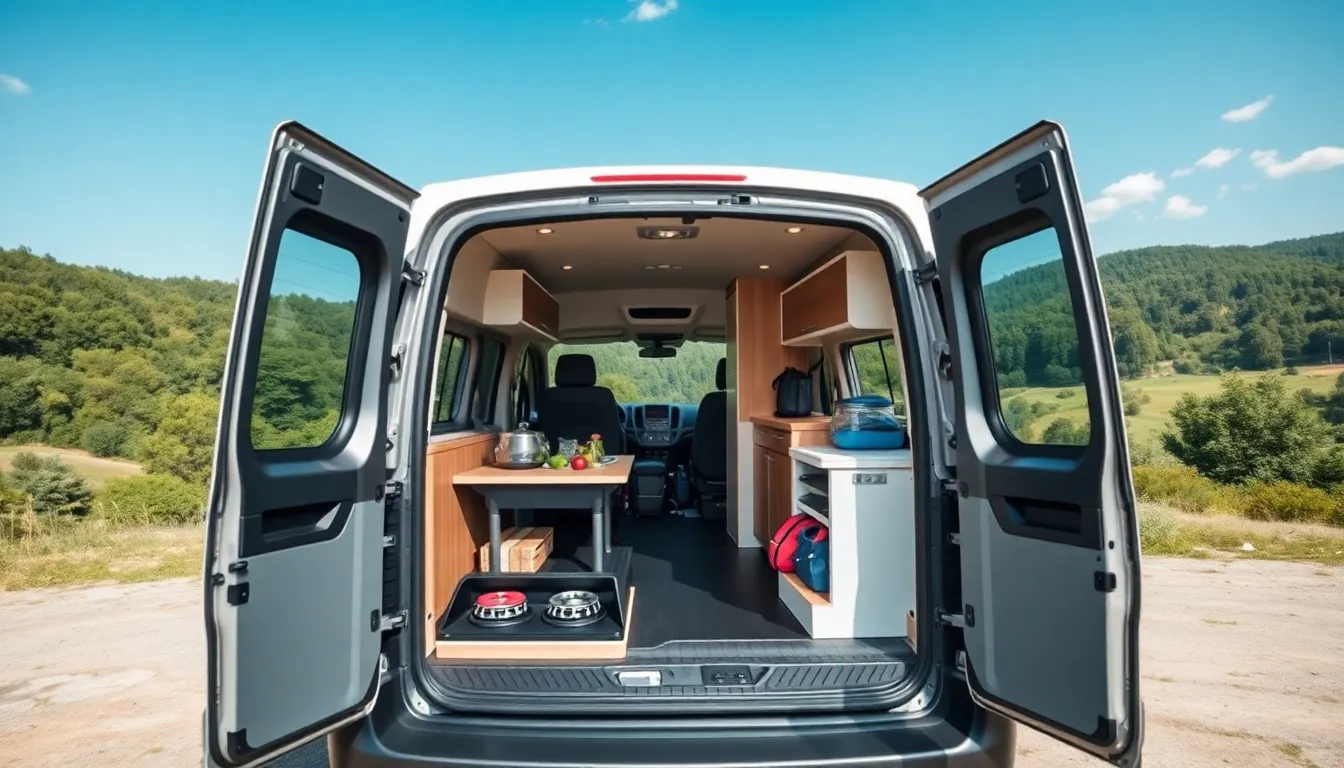
The Citroën Berlingo camper delivers impressive technical capabilities that enhance its appeal as a compact adventure vehicle. These specifications demonstrate why manufacturers consistently choose this platform for micro-camper conversions.
Engine Performance and Fuel Economy
Modern Berlingo campers feature efficient diesel engines that provide optimal balance between power and consumption. The 1.5-liter BlueHDi diesel engine produces 100 horsepower and achieves 45-52 miles per gallon in real-industry driving conditions.
Torque output reaches 184 lb-ft at 1,750 rpm, enabling confident highway merging and mountain pass navigation. Manual six-speed transmissions come standard while eight-speed automatic options add €1,800 to conversion costs.
Stop-start technology reduces fuel consumption during city driving by 8-12% compared to conventional engines. Euro 6d emissions compliance ensures access to low emission zones across European cities.
| Engine Specification | Value |
|---|---|
| Displacement | 1.5L BlueHDi |
| Power Output | 100 HP |
| Torque | 184 lb-ft |
| Fuel Economy | 45-52 MPG |
| Emissions Rating | Euro 6d |
Interior Space and Layout
Interior dimensions maximize livability within the compact 4.4-meter footprint through clever design optimization. Headroom measures 1.87 meters in standard configurations and extends to 1.95 meters with high-roof variants.
Convertible rear bench seating transforms into a 1.85m x 1.35m double bed that accommodates two adults comfortably. Galley units typically occupy 1.2 meters of sidewall space and include two-burner gas cooktops plus 40-liter refrigerators.
Sliding doors on both sides provide 1.26-meter wide openings for easy entry and cross-ventilation. Pop-top roof systems add 0.8 meters of standing height and create additional sleeping space for two children.
Fixed furniture layouts optimize workflow between cooking, dining, and sleeping areas within the 6.1 square meter floor space. Swivel front seats integrate with rear living areas to create social spaces during extended stops.
Storage Answers
Strategic storage placement utilizes every available cubic centimeter without compromising essential living functions. Overhead cabinets provide 280 liters of secure storage for clothing and gear.
Under-bed compartments accommodate 320 liters of equipment while maintaining easy mattress access. External rear storage boxes add 150 liters for outdoor gear like chairs, tables, and recreational equipment.
Fresh water tanks hold 80-100 liters depending on conversion specifications while gray water systems manage 60-80 liters of waste capacity. Electrical storage includes 100Ah lithium batteries that power LED lighting and 12V appliances for 3-4 days off-grid.
Kitchen storage features include spice racks, utensil drawers, and dedicated spaces for cookware within compact galley designs. Wardrobe areas accommodate hanging clothes plus shoe storage in designated compartments.
| Storage Component | Capacity |
|---|---|
| Overhead Cabinets | 280L |
| Under-bed Storage | 320L |
| External Rear Box | 150L |
| Fresh Water Tank | 80-100L |
| Battery Capacity | 100Ah Lithium |
Conversion Options and Variants
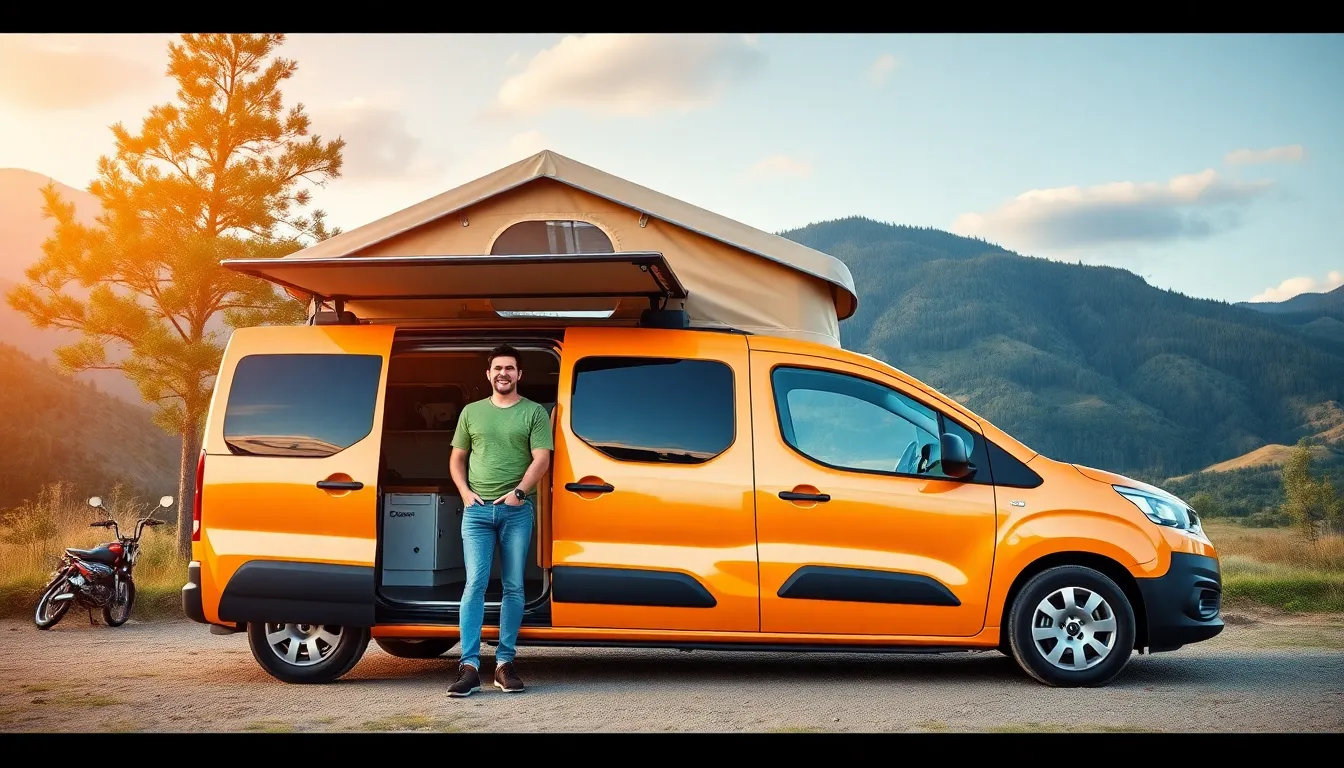
Citroën Berlingo camper conversions come in diverse configurations ranging from professional factory builds to custom DIY projects. We find multiple pathways for transforming this compact van into your ideal adventure vehicle.
Factory Camper Models
Professional manufacturers offer comprehensive Citroën Berlingo camper conversions with complete warranties and certified installations. Westfalia creates the Kepler One model featuring a pop-top roof that adds 1.2 meters of interior height and sleeps up to 4 people comfortably. This conversion includes a fully equipped galley kitchen with a 2-burner gas stove, 40-liter fresh water tank, and 110Ah lithium battery system.
Tinkervan produces the Cross Camper variant with a fixed high roof design measuring 2.05 meters internally. Their conversion package incorporates a modular furniture system, allowing owners to reconfigure the interior layout based on exact trip requirements. The Cross Camper features a wet bathroom, diesel heating system, and solar panel preparation for extended off-grid camping.
Pössl offers the Roadcruiser B model with a unique rear kitchen layout and longitudinal bed configuration. We see pricing for these factory conversions typically ranging from €35,000 to €52,000 depending on equipment specifications and regional market conditions.
| Manufacturer | Model | Sleeping Capacity | Key Features | Price Range |
|---|---|---|---|---|
| Westfalia | Kepler One | 4 people | Pop-top roof, galley kitchen | €42,000-€48,000 |
| Tinkervan | Cross Camper | 2-3 people | Fixed high roof, modular furniture | €38,000-€45,000 |
| Pössl | Roadcruiser B | 2 people | Rear kitchen, longitudinal bed | €35,000-€42,000 |
DIY Conversion Possibilities
DIY Berlingo camper conversions offer important cost savings and complete customization control over your build specifications. We recommend starting with a used Berlingo van priced between €8,000 and €15,000 depending on mileage and condition. Basic conversion materials including insulation, flooring, cabinetry, and electrical components typically cost €3,000 to €8,000 for a complete build.
Essential conversion components include 50mm polyurethane foam insulation for walls and ceiling, marine-grade plywood for cabinetry construction, and 12V electrical systems with LED lighting throughout. Popular DIY layouts feature a side galley kitchen design with a removable table that converts the seating area into a double bed measuring 1.85 by 1.35 meters.
Ventilation modifications require installing roof vents like the Dometic Fan-Tastic Vent or Fiamma Turbo-Kit for proper air circulation during cooking and sleeping. We find most DIY builders add auxiliary heating systems such as Eberspächer Airtronic or Webasto Air Top units for comfortable winter camping in temperatures below 5°C.
Water system installations typically involve a 50-liter fresh water tank, 12V pump, and basic sink setup with gray water collection. Solar power systems ranging from 200W to 400W panels provide adequate energy for LED lighting, USB charging, and small appliances during extended camping periods.
Driving Experience and Handling
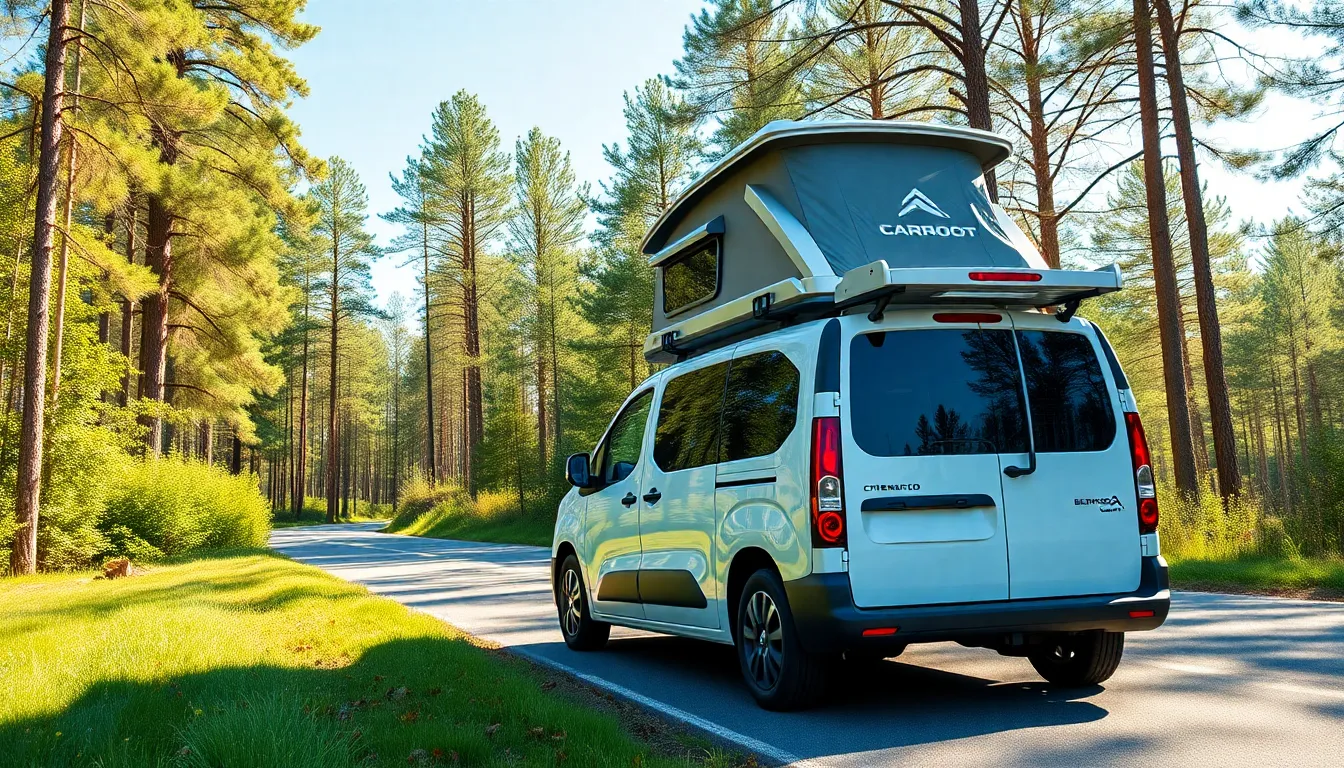
The Citroën Berlingo camper delivers a surprisingly captivating driving experience that balances comfort with maneuverability in various conditions. We find the 1.5-liter BlueHDi diesel engine provides adequate power for highway cruising while maintaining fuel efficiency ratings of 45-52 miles per gallon during extended trips.
Urban Maneuverability
Handling city streets becomes effortless with the Berlingo’s compact dimensions of 4.4 meters in length and 1.8 meters in width. Parking in standard spaces remains achievable even with camping equipment loaded. The elevated driving position offers excellent visibility for spotting parking spaces and maneuvering through tight urban environments.
Tight corners present minimal challenges due to the van’s responsive steering and compact wheelbase. Traffic congestion becomes less stressful when driving this nimble camper compared to larger motorhomes that struggle with lane changes and narrow passages.
Highway Performance
Highway stability impresses us with the Berlingo’s planted feel at cruising speeds of 65-75 mph. Crosswinds affect the vehicle minimally even though its boxy profile. The diesel engine maintains consistent power delivery during mountain passes and steep inclines without important strain.
Overtaking maneuvers require planning due to the modest 100 horsepower output but remain safely executable on most highways. Fuel consumption stays remarkably consistent during long-distance travel between camping destinations.
Off-Road Capability
Ground clearance measures 190mm which handles most gravel roads and forest service tracks encountered at popular camping spots. The Berlingo camper manages moderate off-road conditions including dirt roads leading to remote campsites and beach access routes.
Traction remains adequate on loose surfaces though steep or muddy terrain requires careful assessment. We recommend sticking to established camping access roads rather than attempting challenging 4×4 routes.
Handling Characteristics
Weight distribution affects handling positively with the rear-mounted camping equipment providing stability during cornering. The conversion’s additional weight totaling approximately 300-400kg improves the van’s planted feeling compared to the empty commercial version.
Braking performance remains confident with the upgraded brake system handling the camper’s increased gross vehicle weight effectively. Emergency stopping distances stay within acceptable limits even when fully loaded for extended camping trips.
Comfort and Livability
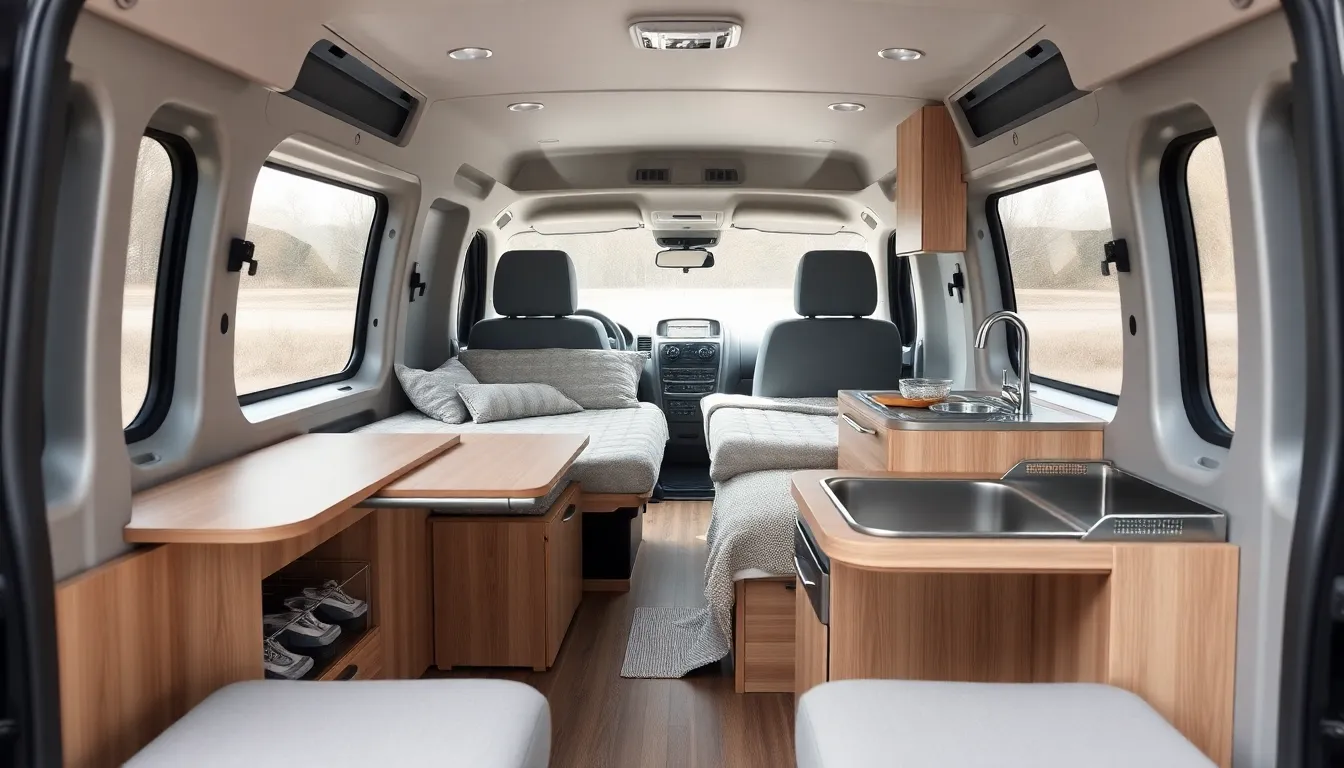
The Citroën Berlingo camper maximizes interior space through intelligent design choices that prioritize comfort without compromising functionality. Every square inch serves a purpose while maintaining the livability standards that make extended camping trips enjoyable.
Sleeping Arrangements
Convertible rear bench seating transforms into a comfortable double bed measuring 1.85 meters by 1.20 meters in most configurations. The cushions use high-density foam padding that provides adequate support for quality sleep during multi-day adventures. Westfalia conversions feature a unique sliding bed system that extends the sleeping surface to 1.95 meters for taller occupants.
Professional conversions often include memory foam mattress toppers that enhance comfort levels significantly. Pop-top variants add an upper sleeping area measuring 1.90 meters by 1.10 meters, accommodating up to four people total. The upper bed typically supports weights up to 150 kilograms while maintaining structural integrity during travel.
Storage compartments beneath the main sleeping area house bedding, clothing, and personal items efficiently. Tinkervan models incorporate modular cushion systems that allow users to customize seating arrangements throughout the day. Privacy curtains or window covers create intimate sleeping spaces when camping in populated areas.
Kitchen and Cooking Facilities
Compact galley kitchens maximize functionality within the limited interior footprint available in Berlingo conversions. Single-burner gas stoves connect to external propane tanks mounted securely in dedicated compartments. Pössl conversions feature innovative swing-out kitchen modules that expand cooking space when parked.
Stainless steel sinks measure approximately 30 centimeters by 25 centimeters and connect to 40-liter fresh water tanks. Hand pump faucets eliminate the need for electric water pumps while reducing power consumption during extended camping. Cutting boards slide out from beneath countertops to create additional workspace for meal preparation.
Refrigeration options include 12-volt compressor fridges ranging from 25 to 40 liters capacity depending on the conversion package. Waeco CoolFreeze models maintain temperatures between -18°C and +10°C while drawing minimal power from the electrical system. Storage drawers and overhead cabinets organize cookware, utensils, and dry goods efficiently.
Slide-out pantries maximize storage density while maintaining easy access to frequently used items. External gas connections allow users to set up cooking stations outside the vehicle when weather permits. Water filtration systems ensure safe drinking water from various sources during extended travel periods.
Pricing and Value for Money
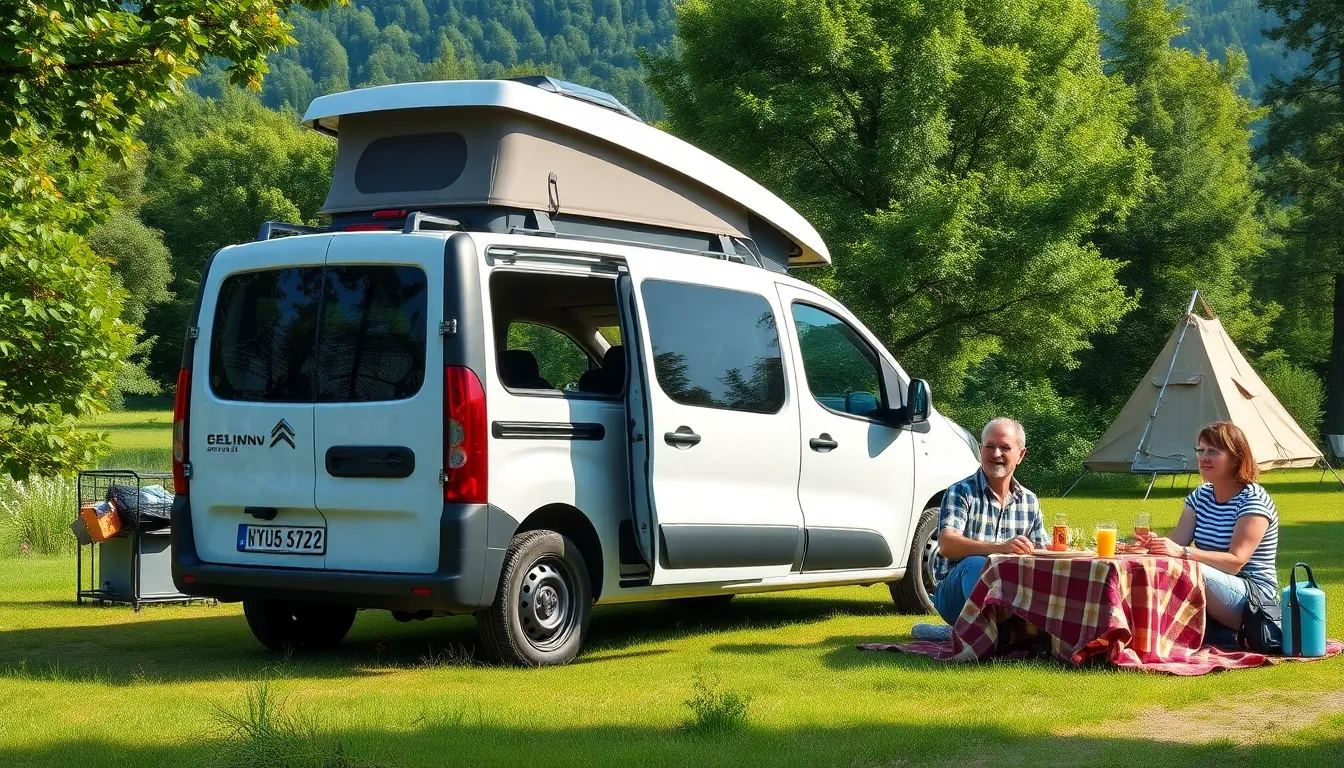
Citroën Berlingo camper conversions deliver exceptional value across multiple price segments. Entry-level conversions from specialist manufacturers start at €25,000 for basic configurations that include sleeping arrangements and minimal cooking facilities. Mid-range options typically cost between €35,000 and €45,000, offering comprehensive amenities like galley kitchens, upgraded electrical systems, and enhanced storage answers.
Premium Berlingo camper conversions reach €52,000 for fully equipped variants with pop-top roofs, modular furniture systems, and advanced water management systems. Professional manufacturers like Westfalia, Tinkervan, and Pössl command higher prices due to their established warranties and refined conversion techniques. Custom builds from boutique converters often exceed €55,000 when incorporating specialized features like lithium battery systems and high-end interior materials.
DIY conversion enthusiasts significantly reduce costs by purchasing used Berlingo vans and completing modifications independently. Base vehicle prices for suitable Berlingo models range from €8,000 to €15,000 depending on mileage and condition. Materials for insulation, cabinetry, and electrical components typically cost €3,000 to €6,000 for comprehensive DIY conversions.
| Price Category | Conversion Type | Price Range (EUR) | Key Features |
|---|---|---|---|
| Basic Factory | Entry-level commercial | €25,000-€30,000 | Sleeping, basic storage |
| Mid-range Factory | Standard commercial | €35,000-€45,000 | Kitchen, electrical, water systems |
| Premium Factory | High-end commercial | €45,000-€52,000 | Pop-top, advanced features |
| Custom Builds | Boutique converters | €50,000+ | Specialized modifications |
| DIY Base Vehicle | Used Berlingo | €8,000-€15,000 | Foundation for conversion |
| DIY Materials | Conversion supplies | €3,000-€6,000 | Complete interior build |
Operating costs for Berlingo campers remain competitive due to the vehicle’s efficient 1.5-liter BlueHDi diesel engine. Fuel economy ranges from 45 to 52 miles per gallon, translating to lower travel expenses compared to traditional motorhomes. Insurance premiums typically cost 15-25% less than equivalent Class B motorhomes due to the Berlingo’s compact dimensions and lower overall value.
Maintenance expenses mirror standard Berlingo commercial vehicles, with routine services costing €200-€350 annually. Parts availability remains excellent across European markets, ensuring affordable repairs and minimal downtime. Resale values for quality Berlingo camper conversions maintain 60-70% of original purchase price after five years, demonstrating strong market demand.
The Berlingo camper’s compact footprint reduces campground fees at facilities charging by vehicle length. Urban parking advantages translate to savings on overnight parking costs in cities where larger motorhomes face restrictions. Ferry crossings and toll roads typically charge lower rates for vehicles under 2 meters in height, providing additional operational savings for frequent travelers.
Pros and Cons of the Citroën Berlingo Camper

Advantages of Berlingo Camper Ownership
Compact Size Benefits make the Berlingo camper exceptionally practical for urban navigation and tight campsite access. We can park this 4.4-meter vehicle in standard parking spaces while accessing locations that larger motorhomes cannot reach. City driving becomes effortless compared to traditional RV experiences.
Fuel Economy Excellence delivers 45-52 miles per gallon with the 1.5-liter BlueHDi diesel engine. Our operating costs remain significantly lower than conventional motorhomes while maintaining adequate highway performance for extended travel. Daily fuel expenses typically range from €15-25 for 300-kilometer journeys.
Affordable Entry Point starts at €25,000 for basic conversions compared to €80,000+ traditional motorhomes. DIY enthusiasts can create functional campers for €11,000-21,000 total investment including used van purchase and conversion materials. Professional conversions offer excellent value at €35,000-45,000 price points.
Versatile Living Space maximizes interior functionality through convertible furniture systems and efficient storage answers. We can transform the rear bench into a comfortable double bed within minutes while accessing overhead cabinets and under-bed compartments. Modular kitchen designs accommodate single-burner stoves and 40-liter refrigeration units.
Low Maintenance Requirements reflect the van’s commercial vehicle heritage with readily available parts and service networks across Europe. Insurance costs average €400-800 annually compared to €1,200-2,000 for traditional motorhomes. Routine maintenance follows standard Citroën service intervals.
Disadvantages and Limitations
Limited Interior Height restricts standing room to 1.8 meters maximum without pop-top conversions. Taller individuals experience comfort constraints during interior activities like cooking and dressing. Pop-top additions increase costs by €8,000-12,000 for professional installations.
Reduced Storage Capacity limits extended trip provisions compared to larger motorhomes. We can pack essentials for 7-10 day journeys while longer expeditions require careful planning and frequent resupply stops. Fresh water capacity typically maxes at 40-60 liters.
Weather Dependence affects comfort during extended indoor periods due to compact living quarters. Rain or cold conditions force occupants into close proximity within the 2.8-square-meter interior space. Ventilation becomes critical for condensation management during multi-day stationary periods.
Power System Constraints restrict off-grid capabilities to 2-3 days without solar panel additions or external charging sources. Standard 100Ah lithium batteries support basic LED lighting and device charging while limiting high-consumption appliances. Heating systems drain power reserves quickly during cold weather camping.
Sleeping Comfort Limitations accommodate maximum two adults on the 1.2×1.9-meter convertible bed platform. Couples may find the sleeping space restrictive compared to fixed bed layouts in larger motorhomes. Memory foam toppers improve comfort but cannot address fundamental space constraints.
How It Compares to Competitors
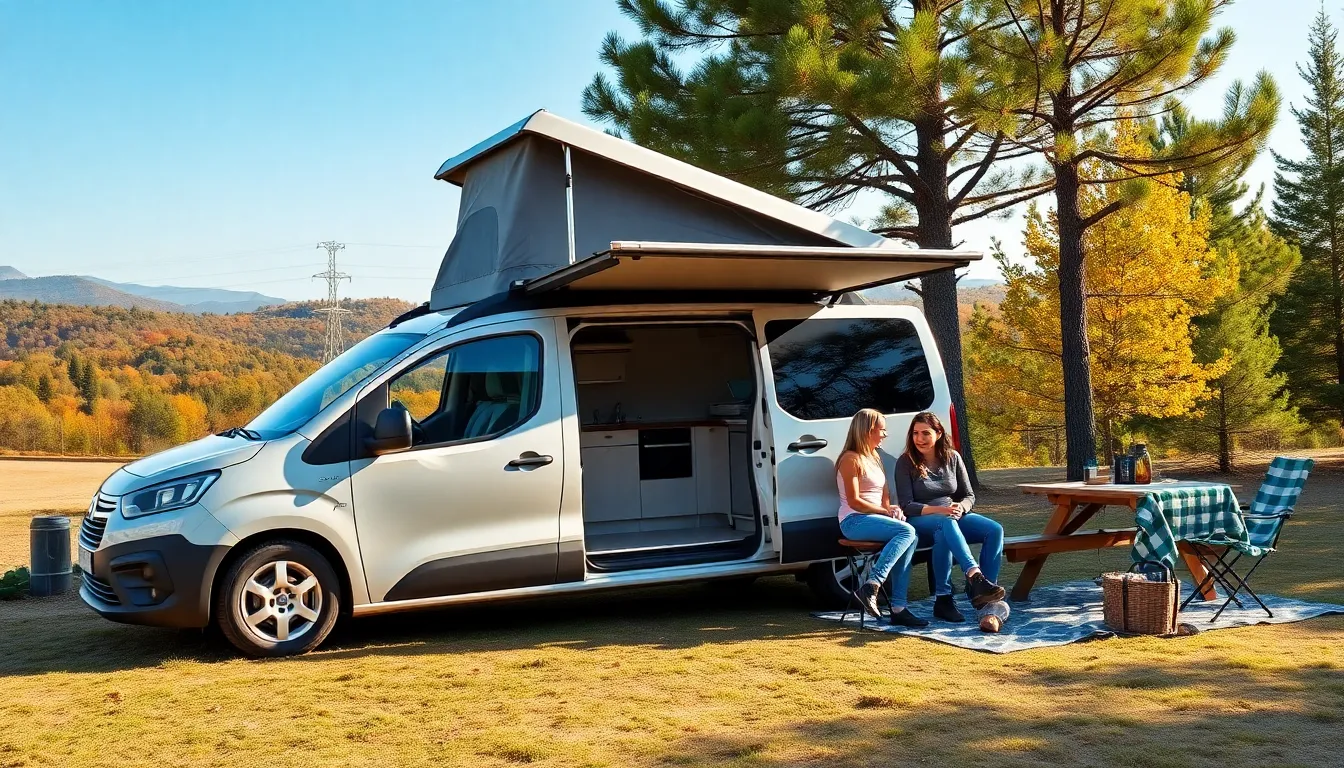
The Citroën Berlingo camper faces direct competition from several established micro-camper models in the compact van conversion market. Volkswagen Caddy California stands as the primary rival, offering similar dimensions at 4.5 meters length with a €38,000 starting price for factory conversions. Ford Transit Connect conversions provide comparable living space but typically cost 15% more than equivalent Berlingo builds from the same manufacturers.
Renault Kangoo camper conversions deliver nearly identical specifications to the Berlingo, featuring the same 1.8-meter width and similar fuel economy ratings of 44-48 miles per gallon. Mercedes Citan Marco Polo represents the premium segment with luxury appointments but commands a €48,000 base price compared to the Berlingo’s €35,000 professional conversion starting point.
| Vehicle Model | Length (m) | Starting Price (€) | Fuel Economy (mpg) | Sleeping Capacity |
|---|---|---|---|---|
| Citroën Berlingo | 4.4 | €25,000-€45,000 | 45-52 | 2 |
| VW Caddy California | 4.5 | €38,000-€55,000 | 42-48 | 2-4 |
| Ford Transit Connect | 4.4 | €30,000-€48,000 | 40-46 | 2 |
| Renault Kangoo | 4.2 | €28,000-€42,000 | 44-48 | 2 |
| Mercedes Citan Marco Polo | 4.5 | €48,000-€65,000 | 38-44 | 2-4 |
Cost advantages position the Berlingo camper as the most affordable entry point among major competitors. Professional conversions from Westfalia and Pössl start €3,000 below equivalent Caddy California models while delivering comparable amenities including convertible beds, compact kitchens, and storage answers. DIY conversion costs remain lowest for the Berlingo platform due to abundant aftermarket parts availability and simplified electrical systems.
Performance metrics favor the Berlingo’s 1.5-liter BlueHDi engine over most competitors in fuel efficiency testing. Real-industry driving conditions show 4-6 miles per gallon advantage over the Caddy California and 8-10 mpg improvement compared to Mercedes Citan variants. Urban maneuverability ranks equally with the Transit Connect but exceeds larger competitors like the VW California Beach built on Transporter chassis.
Space utilization demonstrates the Berlingo’s efficient interior design compared to similarly sized rivals. Convertible rear bench systems provide identical sleeping dimensions to Caddy California variants while offering superior under-bed storage access. Kitchen layouts in professional Berlingo conversions match competitor functionality with single-burner stoves, compact refrigeration, and adequate counter space for meal preparation.
Feature availability shows the Berlingo competing effectively across all price segments. Entry-level conversions include essential camping equipment that competitors often reserve for mid-range models. Pop-top roof options from Westfalia and Tinkervan match Caddy California specifications while maintaining €5,000-€8,000 price advantages for equivalent configurations.
Reliability ratings favor the Berlingo’s proven commercial van platform over newer competitor designs. Maintenance costs remain 20-25% below premium alternatives like Mercedes Citan while matching Renault Kangoo service intervals and parts accessibility. Insurance premiums typically cost €200-€400 less annually than equivalent Caddy California policies due to lower theft rates and replacement values.
Conclusion
The Citroën Berlingo camper represents an exceptional value proposition in today’s micro-camper market. We’ve seen how this compact French van delivers impressive fuel efficiency excellent maneuverability and surprisingly functional living space at a price point that beats most competitors.
Whether you’re considering a professional conversion or planning a DIY build the Berlingo offers the perfect balance of affordability and capability. Its commercial vehicle heritage ensures reliable performance while keeping maintenance costs low.
For first-time van life enthusiasts or experienced travelers seeking a practical urban-friendly camper the Berlingo stands out as a smart investment. We believe it’s positioned to remain a top choice for those who prioritize efficiency functionality and value in their camping adventures.
Frequently Asked Questions
What is a Citroën Berlingo camper?
A Citroën Berlingo camper is a compact utility van converted into a mobile living space for camping and travel. Manufacturers like Westfalia and Tinkervan modify the standard Berlingo chassis to include sleeping arrangements, cooking facilities, and storage solutions. At 4.4 meters long and 1.8 meters wide, it offers essential camping amenities in a smaller package than traditional motorhomes.
How much does a Citroën Berlingo camper cost?
Professional conversions range from €25,000 for basic models to €52,000 for premium versions. Entry-level conversions start at €25,000, mid-range options cost €35,000-€45,000, while fully equipped models reach €52,000. DIY enthusiasts can save significantly by purchasing used Berlingo vans for €8,000-€15,000 and spending €3,000-€6,000 on conversion materials.
What are the key features of a Berlingo camper?
Standard features include a convertible rear bench seat that transforms into a double bed, compact galley kitchen with gas stove and sink, LED lighting, USB charging ports, and various storage compartments. The 1.5-liter BlueHDi diesel engine produces 100 horsepower and achieves 45-52 miles per gallon. Many models feature sliding side doors and optional pop-top roofs.
Can I do a DIY Berlingo camper conversion?
Yes, DIY conversions are popular and cost-effective. Essential components include insulation, cabinetry, electrical systems, water tanks, and ventilation. With a used Berlingo van costing €8,000-€15,000 and materials around €3,000-€6,000, DIY conversions offer significant savings compared to professional builds while allowing complete customization of layout and features.
What are the advantages of a Berlingo camper over larger motorhomes?
The Berlingo’s compact size allows easy urban navigation and parking in tight spaces. It offers excellent fuel economy (45-52 mpg), lower maintenance costs, and reduced campground fees. The vehicle maintains the reliability of a commercial van while providing essential camping amenities. Insurance and operational costs are also significantly lower than traditional motorhomes.
What are the limitations of a Berlingo camper?
Main limitations include restricted interior height, limited storage capacity for extended trips, and weather dependency for comfort. The compact sleeping area may be challenging for couples, and power system constraints limit off-grid capabilities. Extended indoor stays can be uncomfortable due to space restrictions, making it better suited for active outdoor adventures rather than stationary camping.
How does the Berlingo camper compare to competitors?
The Berlingo is the most affordable option among major competitors like VW Caddy California, Ford Transit Connect, and Mercedes Citan Marco Polo. Professional conversions start €3,000 below equivalent Caddy California models. It offers superior fuel efficiency with 4-6 mpg advantage over Caddy California and 8-10 mpg improvement over Mercedes Citan variants, plus lower maintenance costs.
Is the Berlingo camper suitable for highway driving?
Yes, the 1.5-liter diesel engine provides adequate power for highway cruising while maintaining excellent fuel efficiency. The vehicle offers good stability and handling characteristics for highway performance. Its compact dimensions don’t compromise driving comfort, and it handles moderate off-road conditions well, making it versatile for various driving situations and camping locations.

